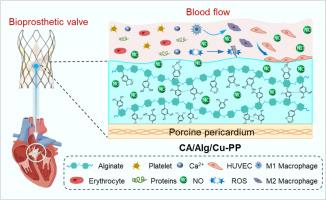内皮功能-仿生水凝胶-表面工程非戊二醛生物瓣膜,具有抗血栓、免疫调节和促内皮化性能。
IF 9.6
1区 医学
Q1 ENGINEERING, BIOMEDICAL
引用次数: 0
摘要
经导管心脏瓣膜置换术的进展显著降低了瓣膜置换术的风险,增加了对生物人工心脏瓣膜(bhv)的需求。目前,与戊二醛交联及其异种胶原基质相关的bhv的血栓形成、内皮化不良、钙化、免疫应答等缺陷加速了bhv的退化。本研究基于仿生儿茶酚交联系统和金属螯合,构建了具有内皮功能的仿生水凝胶表面工程的非戊二醛BHV。通过儿茶酚猪心包(PP)和海藻酸盐(algal - da)的生物激发氧化偶联,将内皮糖萼样层锚定在BHV上,模拟血管内壁的内皮糖萼,同时实现BHV的交联和BHV上生物活性儿茶酚的富集。此外,通过与海藻酸盐和儿茶酚的螯合,将铜离子引入bhv,使bhv具有谷胱甘肽过氧化物酶(GPx)样功能,从而模拟内皮细胞生成一氧化氮(NO)的性能。工程BHV不仅具有抗血栓形成、减轻氧化应激和调节免疫反应的作用,而且还能促进内皮化。此外,大鼠皮下模型bhv的钙化也明显减少。总之,这项工作显示了延长bhv使用寿命的巨大潜力。意义声明:生物人工心脏瓣膜(bhv)容易因血栓形成、内皮化不良、钙化和免疫反应而变性,这与戊二醛交联的缺陷及其异种胶原基质密切相关。基于儿茶酚交联和金属-酚化学,我们设计了一种具有内皮功能仿生水凝胶表面的非戊二醛BHV,以防止血栓形成,减少钙化,增强内皮化和免疫调节。内皮功能仿生水凝胶表面抵抗血液污垢和血栓形成,形成富含儿茶酚的实体,以减轻氧化应激和调节免疫反应。铜离子的掺入赋予gpx样功能,模拟内皮一氧化氮的生成并促进内皮化。这项工作有可能延长bhv的使用寿命,并为下一代多功能bhv提供了一个有希望的候选产品。本文章由计算机程序翻译,如有差异,请以英文原文为准。

Endothelial function-biomimetic hydrogel-surface engineered non-glutaraldehyde bioprosthetic valve with antithrombotic, immunomodulatory and pro-endothelialization performance
The progress of transcatheter valve replacement has significantly reduced the risk of valve replacement, increasing the demand for bioprosthetic heart valves (BHVs). Currently, the defects of BHVs, including thrombosis, poor endothelialization, calcification, and immune responses that are associated with glutaraldehyde crosslinking and their xenogeneic collagenous matrix, have accelerated the degeneration of BHVs. Herein, we constructed an endothelial function biomimetic hydrogel surface engineered non-glutaraldehyde BHV based on bioinspired catechol-crosslinking system and metal-chelation. An endothelial glycocalyx-like layer was anchored on BHV through the bioinspired oxidative coupling of catecholic porcine pericardium and alginate to mimic the endothelial glycocalyx on the inner wall of blood vessels, by which we also simultaneously achieved the crosslinking of BHV and the enrichment of bioactive catechols on BHV. Furthermore, the copper ions were introduced through chelation with alginate and catechol to impart glutathione peroxidase (GPx)-like functionality to BHVs, which mimicked the nitroxide (NO) generation performance of endothelium. The engineered BHV not only resisted the thrombosis, alleviated oxidative stress and modulated the immune responses but also facilitated the endothelialization. Moreover, the calcification of the BHVs was also significantly reduced in rat subcutaneous model. Altogether, this work presents significant potential to prolong the service life of BHVs.
Statement of Significance
Bioprosthetic heart valves (BHVs) are prone to degeneration due to thrombosis, poor endothelialization, calcification, and immune responses which are closely associated with the defects of glutaraldehyde crosslinking and their xenogeneic collagenous matrix. Based on catechol cross-linking and metal-phenol chemistry, we engineered a non-glutaraldehyde BHV with an endothelial function biomimetic hydrogel surface to prevent thrombosis, reduce calcification, and enhance endothelialization and immunomodulation. The endothelial function biomimetic hydrogel surface resists blood fouling and thrombosis, forming a catechol-rich entity to alleviate oxidative stress and modulate immune responses. The incorporation of copper ions confers GPx-like functionality, mimicking endothelial nitric oxide generation and facilitating the endothelialization. This work holds potential to extend the lifespan of BHVs and presents a promising candidate for the next generation of multi-functional BHVs.
求助全文
通过发布文献求助,成功后即可免费获取论文全文。
去求助
来源期刊

Acta Biomaterialia
工程技术-材料科学:生物材料
CiteScore
16.80
自引率
3.10%
发文量
776
审稿时长
30 days
期刊介绍:
Acta Biomaterialia is a monthly peer-reviewed scientific journal published by Elsevier. The journal was established in January 2005. The editor-in-chief is W.R. Wagner (University of Pittsburgh). The journal covers research in biomaterials science, including the interrelationship of biomaterial structure and function from macroscale to nanoscale. Topical coverage includes biomedical and biocompatible materials.
 求助内容:
求助内容: 应助结果提醒方式:
应助结果提醒方式:


